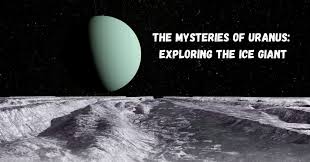When it comes to exploring our solar system, the outer planets always spark curiosity due to their sheer size, unique compositions, and extreme weather patterns. Among these celestial giants, Uranus stands out as a particularly enigmatic world. Despite being discovered over two centuries ago, it remains one of the least explored planets in our cosmic neighborhood. In this article, we’ll delve into everything scientists know and don’t know about the Uranus surface, uncovering the mysteries that lie beneath its icy clouds.
Understanding Uranus: An Overview
Uranus is the seventh planet from the Sun and was discovered in 1781 by astronomer William Herschel. With a pale blue color caused by methane in its upper atmosphere, Uranus may look serene, but beneath the surface lies a realm of intense pressure, extreme cold, and possibly even exotic oceans.
Does Uranus Have a Solid Surface?
One of the most common questions from space enthusiasts is: Does Uranus have a surface we could stand on? The answer is no, the surface as we think of it (solid ground like Earth) doesn’t exist. Uranus is made mostly of hydrogen, helium, and ice. There is no distinct boundary between the atmosphere and the “surface” because the gases gradually become denser with depth, transitioning into a slushy mix of ice and water.
So, when we refer to the Uranus surface, we’re usually talking about the region where the atmospheric pressure equals 1 bar, similar to Earth’s surface pressure. But even this “surface” would be made up of gas, not rock or solid material.
Layers Beneath the Uranus Surface
1. Upper Atmosphere
The topmost visible layer consists mainly of hydrogen, helium, and a small amount of methane. The methane absorbs red light and reflects blue, giving Uranus its iconic hue.
2. Lower Atmosphere
As you descend, the pressure increases, and temperatures drop to a frigid -224°C, making Uranus the coldest planet in the solar system. Despite being far from the Sun, scientists believe internal processes also influence this chilling environment.
3. Icy Mantle
This is often referred to as the “mantle.” It’s neither gas nor liquid but a high-pressure fluid that may conduct electricity, possibly driving Uranus’s unusual magnetic field.
4. Core
However, it’s smaller and less massive compared to Jupiter’s or Saturn’s cores.
Surface Conditions on Uranus
If you could descend into Uranus, you’d face some of the most extreme conditions in the solar system. With no solid Uranus surface to stand on, you’d fall through layers of increasingly dense and cold gases. The pressure and temperature would eventually become lethal.
Here are some fascinating Uranus surface facts (in the atmospheric sense):
- Temperature: Average around -224°C.
- Winds: Can reach speeds of 900 km/h (560 mph).
- Gravity: Slightly less than Earth (0.89g).
- Magnetic Field: Tilted and off-center, making it unpredictable.
The Tilted Giant
Another intriguing aspect of Uranus is its 98-degree axial tilt. The planet essentially rolls around the Sun on its side, which dramatically affects seasonal patterns and atmospheric circulation. This unusual orientation could also impact the structure of the Uranus surface layers and internal heat distribution.
Challenges in Studying the Uranus Surface
Because Uranus is so distant, about 2.9 billion kilometers (1.8 billion miles) from Earth, it’s incredibly difficult to study. Only one spacecraft, NASA’s Voyager 2, has flown by Uranus, back in 1986. The limited data we have makes understanding the Uranus surface a major challenge.
In recent years, scientists have advocated for a dedicated Uranus Orbiter and Probe Mission. Such a mission would provide a detailed look at the planet’s interior, atmosphere, rings, and potential moons with subsurface oceans.
Possibility of Life on Uranus?
Could life exist in the icy depths of Uranus? While it seems unlikely due to the extreme cold and lack of a solid surface, some scientists speculate that deep in the interior, where temperatures and pressures are higher, exotic chemical reactions might occur. Still, Uranus remains a highly hostile environment for life as we know it.
Future Exploration: Unlocking the Uranus Surface Mystery
In 2022, U.S. A potential launch in the 2030s could finally give us the close-up data needed to analyze the planet’s atmosphere, magnetic field, moons, and interior.
A future probe could descend into the atmosphere, measure temperature and pressure gradients, and even explore how the gas layers transition into the icy mantle, bringing us closer to understanding what the Uranus surface truly consists of.
Conclusion
While Uranus may not have a solid surface, the concept of the Uranus surface still plays a crucial role in planetary science. It serves as a benchmark for atmospheric studies and helps scientists model planetary formation and evolution.
As technology advances and interest grows, we may soon unlock the secrets hiding beneath its cloud tops.



